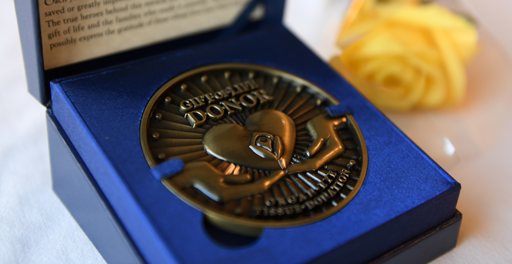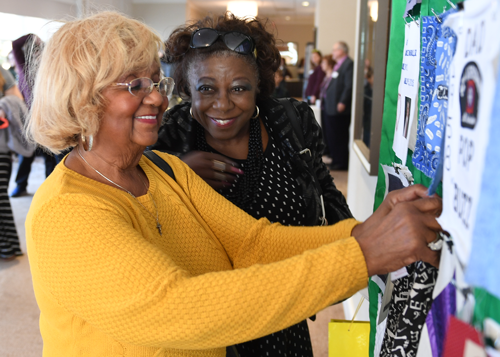A Clinical Transplant Coordinator’s Lessons on Organ Donation
A Clinical Transplant Coordinator’s Lessons on Organ Donation
by Loren Talbot
 With over 100,000 people nationally waiting for an organ transplant, INELDA is highlighting April’s National Donate Life Month by demystifying the process of organ and tissue donation and transplantation.
With over 100,000 people nationally waiting for an organ transplant, INELDA is highlighting April’s National Donate Life Month by demystifying the process of organ and tissue donation and transplantation.
I had the pleasure of sitting down with Victoria Burns, CPTC, CT, RN clinical transplant coordinator, and University of Vermont-trained end-of-life doula who shared how her employer of 14 years—Gift of Life Donor Program in Philadelphia—has coordinated more than 55,000 organ transplants and more than 2 million tissue transplants since 1974. For 14 consecutive years, Gift of Life has led the nation by coordinating the most organs for transplant. In 2021, it coordinated donations from 705 donors, the most ever in U.S. history. Through these donors, Gift of Life achieved the highest number of lifesaving organ donations ever recorded in U.S. history.
“We live in one of the most generous areas of the country. The number of families that support the legacy of donation and the patients who have chosen designation on their driver’s license is just humbling,” says Victoria. Coordinating the legacy of donation relies on the generous hearts of the people doing this work.
Coordination of Organ and Tissue Donation
The U.S. Department of Health and Human Services, through the Centers for Medicare and Medicaid Services, keeps a federal list of individuals who need an organ transplant. It takes many folks to ensure the recovery is safely coordinated so the organ reaches a match on the donor list. The transplant team consists of coordinators, physicians, surgeons, and social workers—all of whom are needed to make a transplant successful. When an organ becomes available, candidates are screened for blood type, height, weight, and other medical factors in accord with national policies.
The transplant surgeon considers geography to ensure that the gift can be transplanted within a specified time frame. Organs such as the heart, lungs, liver, kidneys, and intestines are eligible for consideration for transplant. Additionally, tissues such as cornea, skin, heart valves, bone, and blood vessels can be donated as life-enhancing gifts. Over recent years, the transplant community has had success with vascularized composite allografts. This new and exciting life-enhancing opportunity has been in the forefront of the media, with stories of uterus donations resulting in successful births, and face, hand, and arm transplants giving hope to catastrophically injured patients.
The United Network for Organ Donation (UNOS) is responsible for managing the transplant system in the United States. It oversees such things as the wait list, allocation policies for recipient identification, waiting list criteria, and education. Fifty-seven organ procurement organizations (OPOs), such as the Gift of Life Donor Program, serve the 11 regions of the United States and work closely with UNOS. These OPOs are the bridge between the hospital and the patients waiting on the list for a gift of life.
Organ Donation 101
People who have decided to include organ donation as part of their end-of-life legacy can include this information on their driver’s license or state ID card. This will then automatically enroll them in a national donor database. Additionally, “Telling your family/agent that you wish to include this amazing legacy as a part of your end-of-life care plan is probably the single most important thing an individual can do. Not only does it empower you to share your decision, but can bring great comfort to loved ones, knowing you made the decision so that they do not have to,” says Victoria. The OPO works closely with the family to share this decision with them and to discuss how donation will be incorporated into end-of-life plans. In the case of no designation or an inability to find legal documentation, the legal next of kin receives information from the OPO and is supported through making an informed and enduring decision.
In all cases when donating organs during end of life, an individual must be supported on a respiratory device (ventilator, BiPap) and in a hospital setting. A declaration of brain death or circulatory death will determine what gifts may be transplanted. Donations can include organs for transplant and tissue used for life-enhancing surgeries. When a patient is evaluated for donation, there are two pathways in which this may be offered: donation after brain death and donation after circulatory death.
When a family has made a difficult decision to transition their loved one to comfort-focused care or treatment, the OPO may evaluate the patient. If the patient is a candidate for donation, the option to donate may be offered. This is when “the family has been told by the health care team that survival is not possible, that the devastating injuries would result in no quality of life,” says Victoria. When a family makes the decision to terminate life support and transition to palliative or comfort-focused care where the intention is to remote respiratory support, and if the patient is a candidate, the OPO can then approach the family and offer the option known as donation after circulatory death.
“This is probably my favorite pathway to coordinate as a transplant coordinator,” Victoria says. “This is when I feel the most like a doula, by walking alongside a family when they are facing this devastating loss, helping to coordinate what I believe to be a good death, working alongside the care team. The physicians oversee care and comfort of the patient as they normally would. The only difference is when life support is discontinued, if the patient dies within a reasonable period, we will shortly thereafter begin surgery to recover their gifts.”
Families are supported through this intimate time and can remain with their loved ones during their final moments, incorporating into that time things they may find meaningful. This may include special music and prayers. Patients who are able to save lives this way may have a nonsurvivable stroke, sudden trauma, a degenerative disease, or prolonged absence of oxygen, as seen with cardiac arrest.
Another pathway that would allow for donation is that in which a patient is determined to be brain dead. These patients meet the criteria for death as defined by the American Academy of Neurology. Families require immense support in understanding that death has in fact occurred and that the patient’s breathing has permanently stopped and a ventilator, or breathing machine, must be used to keep the body functioning. Families do not need to make a heartbreaking decision to terminate support, as the patient is legally considered dead and is given a time of death based on this criteria. The patients are supported on breathing machines to allow the opportunity for donation.
Many patients who are in hospice are not on a ventilator or perhaps not in a hospital setting at all. “It is important to know that we have worked successfully with patients and families who have a noncancer diagnosis, such as ALS or primary brain cancer, who have opted for temporary breathing support for the purpose of ensuring the legacy of organ donation. Decisions such as these are fully informed and driven by the patient making their own end-of-life plans,” says Victoria.
One person’s decision to become an organ donor can impact the lives of up to eight people on the transplant waitlist. Another person’s ability to become a tissue donor can heal and transform the lives of 50 to a 100 people receiving their gifts. There are no barriers based on age, race, or religion when registering to save lives. While active, metastatic cancer makes organ donation impossible, patients with a remote history of treated cancer may be able to donate. Patients with HIV and hepatitis are no longer excluded from saving lives. For example, an individual who may have carried HIV can donate an organ to another person who has HIV. “For those of us who are doulas or are part of a hospice/palliative support care team, it is important to know that most cancers do not impact the patient’s ability to have an amazing legacy of giving the gift of sight through cornea donation,” says Victoria. Also, the age of donors is constantly evolving with scientific breakthroughs, making the oldest recorded organ donor in history 95 years old.
Families who are navigating the tragedy of perinatal loss may have the opportunity for heart valve donation. “These families will share how meaningful it is to them to know that something good came out of such a heartbreaking tragedy. It is often the one thing that gives them hope in the face of a devastating child loss,” says Victoria.
 Family Aftercare
Family Aftercare
Many OPOs work closely with families to support their loved one’s choice as a donor. The connection does not end with coordinating the recovery of organs and tissues; it can carry on for years. “The donor family first interacts with a coordinator who is experienced in helping a family navigate through end of life—not just with a heart for donation, but with a heart for families experiencing horrific loss when they have that. Our amazing health care teams know when the family has transitioned after the loss of their loved one, these families are then connected with a master’s-prepared social worker who specializes in bereavement,” says Victoria. “We have our continued family support services. They then help to oversee a letter that is sent to the family explaining what legacy was given.”
Gift of Life hosts Life and Legacy Celebrations to honor the heroic organ donors and their family members. The OPO also built the Gift of Life Family House in 2011, a subsidized hospitality house that provides transportation, meals, caregiver support, and a home away from home for families along their transplant journeys.
For families who may not have been able to see a donation to fruition because of medical reasons, emphasizing that they had given the gift of hope at the memorial or obituary can be an important part of their loved one’s legacy. Doulas can play a supportive role for clients seeking to make this life-saving gift part of their end-of-life plan and can supply the necessary donor resources for those who hope to pass on this gift that extends beyond their time on earth.
